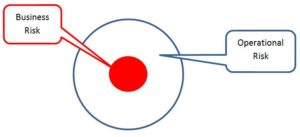In the healthcare industry, we are surrounded by risk. We have offices that are dedicated to the subject. Yet, rarely are risk assessments performed on the supply chain.
They should be. The supply chain holds major, but often invisible, risks to the healthcare industry.
 There are two major risk categories that affect the healthcare supply chain; Business Risk and Operational Risk.
There are two major risk categories that affect the healthcare supply chain; Business Risk and Operational Risk.
Business Risk has the greatest amount of visibility as it has the greatest immediate impact on the organization. For instance, a new Magnetic Resonance Imaging (MRI) suite is being installed and must be available for use by a certain date. This piece of capital equipment has the attention of many people! Another example might be the award of a new contract for IV Pumps to replace the aging fleet of older pumps.
Operational Risks are not so visible, yet can be immediately thrust to the forefront if a problem occurs. Operational Risks, when made visible, are often found in the public in newspapers, television, and on the internet. Examples of Operational Risks are,
- An equipment manufacturer is unable to meet a demand because one of its suppliers (off shore) is unable to meet its own demand AND there are no U.S. manufacturers of this supply.1
- Injectable medication has been identified as having been tainted and it is unknown if the hospitals supply chain is affected.2
- Nuclear Medicine Camera, with no apparent reason, falls on a patient.3
- Surgical equipment requiring a specialized cleaning regimen is labor-intensive when following the manufacturer’s instructions.4
Healthcare Supply Chain Managers must be mindful of the potential impact that Operational Risks pose to the supply chain and the healthcare system. Recognizing and assessing the potential for these risks early in the acquisition allows the manager to develop strategies to mitigate the outcome.
A common tool used to assess risk is the Failure Modes and Affects Analysis (FMEA). The FMEA allows for a more in-depth identification and understanding of the potential risks which may befall the product or service being acquired, assess (rate and rank) its effect on the system, and provide mitigation strategies. While this may seem like overkill in the beginning, should a problem occur, you will be glad you did this.
***************************************************
1 http://www.fda.gov/downloads/aboutfda/reportsmanualsforms/reports/ucm277755.pdf
2 http://www.fda.gov/Drugs/DrugSafety/FungalMeningitis/default.htm
3 http://www.medscape.com/viewarticle/805801
4 http://www.auntminnie.com/index.aspx?sec=ser&sub=def&pag=dis&ItemID=103917
For more information on the FMEA model, visit http://en.wikipedia.org/wiki/Failure_mode_and_effects_analysis. The Department of Veterans Affairs, National Center for Patient Safety developed a healthcare version of FMEA called HFMEA which can be found at http://www.patientsafety.va.gov/CogAids/HFMEA/index.html#page=page-1
JAMES N. PHILLIPS JR., MPA, CFCM, NCMA Fellow, is an Acquisition Professional working at the Department of Veterans Affairs National Center for Patient Safety. Disclaimer: his comments are that of his own and do not reflect that of the Department of Veterans Affairs or the National Center for Patient Safety.

Healthcare Supply Chain Managers need to coordinate with other departments like Pharmacy, Risk Management, PI/QA. Medication/Patient Safety Officers have existed in hospitals for many years and may fall under PI/Risk Management or the P and T Committee. The Joint Commission has focused on Sentinel Events for many years and IHI began addressing Potential Adverse Drug Events going back to 1995 and FMEA became part of every hospital PI/QA model. Look alike/Sound alike (LASA) has been used in hospital pharmacy departments in the selection of drugs for 20 years or more.
We used to use ECRI when we were selecting products also.
Patient Safety begins at the selection process, whether it’s a drug, device, diagnostic, or other form of technology.